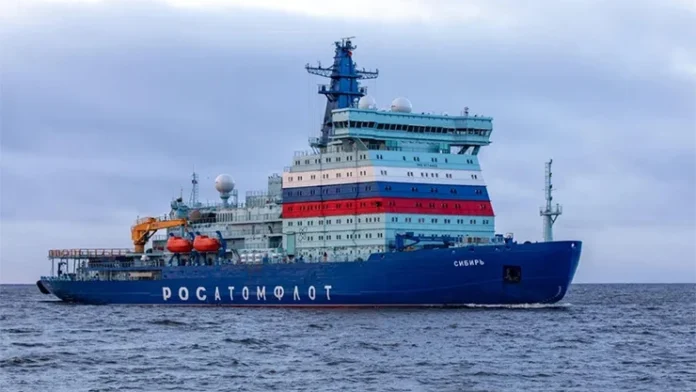India has proposed to Russia that the two countries collaboratively manufacture non-nuclear icebreakers in Indian shipyards. Alexey Chekunkov, the Russian Federation’s Ministry of Eastern Development director, announced this on Wednesday (September 13, 2023) in an interview with Sputnik and RIA Novosti on the sidelines of the 8th Eastern Economic Forum (EEF) held at the Far Eastern Federal University (FEFU) campus in Vladivostok, Russia, from September 10-13, 2023. Earlier, Chekunkov was in talks with an Indian business delegation that attended the EEF.
“This is a continuation of the work we started in March this year. At my invitation, the Indian Minister for Ports and Shipping came to Russia. It was his first visit to Russia. India is interested in training personnel for Arctic navigation. We’ve put forward a proposal for the joint creation of non-nuclear icebreakers at Indian shipyards. We’re appraising this proposal,” Chekunkov said.
According to him, a comprehensive approach must be taken to all issues of strategic importance to Russia, including the organisation of joint transport, including container lines. He pointed out that this necessitates diversifying mutual trade and shipbuilding and that India is home to numerous shipyards. In addition, the minister stated that he would assist in organising a dialogue between Russian shipbuilders and the Indian industry.
Chekunkov said agreements had also been reached with the Indian side regarding establishing a mechanism for comprehensive dialogue between India and Russia and the State Atomic Energy Corporation Rosatom on the subject of Arctic cooperation and the development of the Northern Sea Route as an important transit hub. Chekunkov recalled that the delegation from India negotiated with FESCO on the organisation of container transportation. It was reported that FESCO plans to open a hub in India to organise freight transportation.
The minister also mentioned that, in conjunction with the Indian Ministry of Ports, Shipping and Waterways, there were plans to initiate a maritime line connecting the port of Chennai in India and the city of Vladivostok in Russia.
Russia’s Icebreaker Challenges
India is among the few nations Russia has awarded investment opportunities in oil and gas and the diamond industry. India has made substantial financial commitments towards Russia’s oil and gas sector. The escalating energy scarcity in India has reached a critical juncture, resulting in a deceleration of the nation’s progress due to the escalating costs associated with imports. Hence, India must establish enduring contractual agreements with Russia to procure petroleum products, mirroring the approach adopted by China. India possesses a substantial pool of technically proficient individuals alongside its shipyard facilities.
The Russian authorities safeguard the local shipbuilding industry and implement such protective measures as placing government orders exclusively at Russian shipyards. Nevertheless, due to the severe scarcity of icebreakers and the delay at Russian shipyards, the Russian authorities are compelled to contemplate China and India as prospective collaborators. India has not previously engaged in the construction of icebreakers, but China has recently accomplished the delivery of a substantial icebreaker vessel and other trading vessels with ice-class capabilities.
Russia has acquired a significant amount of rupees due to its shift towards conducting trade in domestic currencies. It would be advantageous to utilise these rupees as a means of payment for goods produced in India. According to former Prime Minister Dmitry Medvedev’s statement in 2022, it was projected that three out of the six nuclear icebreakers operated by Rosatom would become inoperative by 2027.
According to the Northern Sea Route (NSR) Directorate, at least seven icebreakers—ideally up to 14—will be required to guarantee uninterrupted travel throughout the year. If vessels are not replaced with newly designed ships in the near future, there is a potential risk of a shortfall in icebreaker capacity by 2030. Additional challenges encompass the repercussions of sanctions, which result in diminished imports of foreign-manufactured equipment, a constrained internal supply chain for critical components and a dearth of skilled workforce.
India and the Arctic Region
India currently maintains two functional polar research outposts in Antarctica: Bharati and Maitri. The country operates a research station named Himadri, situated in Ny-Ålesund in Svalbard, Norway, marking its presence in the Arctic region. India has conducted a total of 40 scientific missions to Antarctica, as well as 13 expeditions to the Arctic region. All Arctic trips to date have been carried out using privately contracted polar research vessels from other countries. In 2021, India procured the services of the Russian freight icebreaker, Dmitry Golovnin, to conduct an expedition to Antarctica.
India engages in actively constructing diverse categories of vessels. However, it has thus far encountered challenges in developing an icebreaker. One of the primary challenges faced during the construction process was the insufficient capabilities of Indian shipyards. It is evident that, in the early phase, the Indian authorities strongly desired to acquire technological advancements and specialised knowledge in the domain of icebreaker ship construction from Russia.
Non-Nuclear Icebreaker Ships
Non-nuclear icebreaker ships are vessels that can break through ice without using nuclear power as their main energy source. They are usually powered by diesel engines or gas turbines and have reinforced hulls and propellers to withstand the pressure and impact of ice. Non-nuclear icebreaker ships are used for various purposes in the Arctic region, such as scientific research, exploration, tourism, emergency response and commercial shipping.
Non-nuclear icebreaker ships have some advantages and disadvantages compared to nuclear-powered icebreakers.
Some of the advantages are:
-
They are cheaper to build and operate than nuclear-powered icebreakers
-
They do not pose any risk of nuclear accidents or radiation leaks
-
They do not face any political or environmental opposition from other countries or organisations
Some of the disadvantages are:
-
They have less power and endurance than nuclear-powered icebreakers, which means they can break through thinner ice and travel shorter distances without refuelling
-
They emit more greenhouse gases and pollutants than nuclear-powered icebreakers, which contributes to global warming and environmental degradation
-
They depend on the availability and price of fossil fuels, which can fluctuate and affect their operational costs
Non-nuclear icebreaker ships are becoming more important for the Arctic region as the ice is melting due to climate change, creating new opportunities and challenges for various stakeholders. The Arctic region holds vast natural resources—such as oil, gas, minerals and fish—that can be exploited for economic benefits. The Arctic region also offers new routes for shipping, such as the Northern Sea Route and the Northwest Passage, which can reduce the distance and time between Asia, Europe and North America. However, the Arctic region also faces many threats—such as territorial disputes, military tensions, illegal activities, environmental hazards and indigenous rights issues.
Therefore, non-nuclear icebreaker ships can play a vital role in facilitating access, cooperation and security in the Arctic region. However, they also need to be regulated and coordinated with other countries and organisations to ensure the peaceful and sustainable development of the area.
–The author of this article is a Defence, Aerospace & Political analyst based in Bengaluru. The views expressed are of the author and do not necessarily reflect the views of Raksha Anirveda
-The author is a Defence, Aerospace & Political Analyst based in Bengaluru. He is also Director of ADD Engineering Components, India, Pvt. Ltd, a subsidiary of ADD Engineering GmbH, Germany. You can reach him at: girishlinganna@gmail.com. The views expressed are personal and do not necessarily carry the views of Raksha Anirveda






